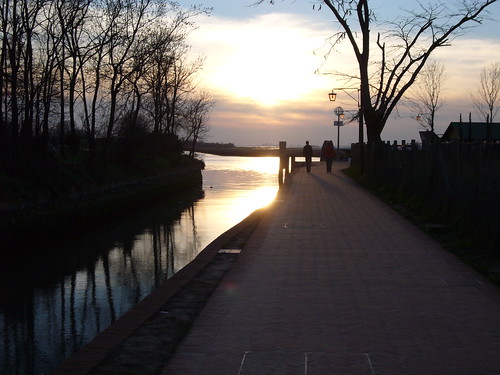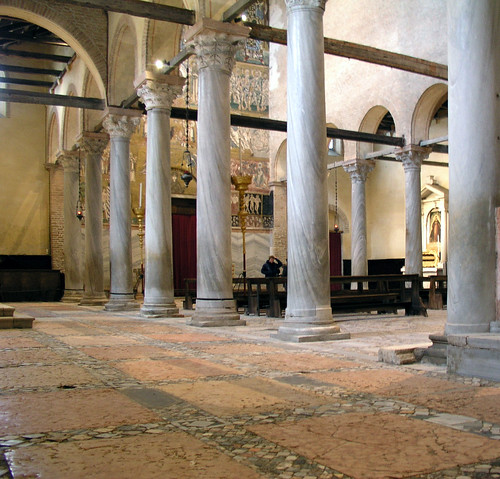From Volume I, Chapter III ("Torcello"). This was a short chapter, and I only have a few notes on it. Torcello is an island seven miles north of the main islands of Venice that was settled as early, or even earlier, than they were, was home to a small population for close to a thousand years or thereabouts, and then abandoned, leaving a pair of churches, a tower and a few other odd ruins to fall into disrepair. These ruins revealed to Ruskin a character of the sort of human society of which he approved, and did not find anywhere among the men of his own time.
 Ruskin calls the view from the top of the campanile "one of the most notable scenes in this wide world of ours." I wrote at the time that it was hard to submit to such claims of greatness without seeing the examples clearly, which evidently I felt I was not doing that day. I may also have been at the moment slightly weary of Ruskin's pronouncements, for he was a great, as well as a severe pronouncer, though I ought to remember that for all that he seems to have felt as if no one was ever really listening to him or understood what he meant, which made him even more furious and despondent. Besides, the scene he is writing about is quite obviously more than ordinarily beautiful and poignant with human meaning, so I do not know what I was being so haughty about.
Ruskin calls the view from the top of the campanile "one of the most notable scenes in this wide world of ours." I wrote at the time that it was hard to submit to such claims of greatness without seeing the examples clearly, which evidently I felt I was not doing that day. I may also have been at the moment slightly weary of Ruskin's pronouncements, for he was a great, as well as a severe pronouncer, though I ought to remember that for all that he seems to have felt as if no one was ever really listening to him or understood what he meant, which made him even more furious and despondent. Besides, the scene he is writing about is quite obviously more than ordinarily beautiful and poignant with human meaning, so I do not know what I was being so haughty about. "And though it may appear, at first sight, that the procedure is indicative of bluntness and rudeness of feeling, we may perceive, upon reflection, that it may also indicate the redundance of power which sets little price upon its own exertion." He is referring here to the marble sculpture work in the church.
"And though it may appear, at first sight, that the procedure is indicative of bluntness and rudeness of feeling, we may perceive, upon reflection, that it may also indicate the redundance of power which sets little price upon its own exertion." He is referring here to the marble sculpture work in the church."...the exertion of design is so easy to them, and their fertility so inexhaustible..." These fragments of course do not do the chapter justice--it is really a meditation on what are the indicators, as expressed through the arts, of a thriving, properly realized society of men. Artistic endeavor, he says repeatedly through the book, is a proper and natural activity of healthy men, which the modern (19th-century) world has fetishized and deprived the mass of men from any meaningful participation in.
 "...whatever ornaments we admit ought clearly to be of a chaste, grave, and noble kind; and what furniture we employ, evidently more for the honoring of God's word than for the ease of the preacher." He is here praising the hard, unadorned but still graceful and eminently serviceable stone pulpit found in the church of Santa Maria Fosca on Torcello (pictured above). He goes on a bit of a rampage, lasting several pages, about overly elaborate and luxurious pulpits, and their inverse relationship to sermons of profound religious feeling and understanding being delivered from them.
"...whatever ornaments we admit ought clearly to be of a chaste, grave, and noble kind; and what furniture we employ, evidently more for the honoring of God's word than for the ease of the preacher." He is here praising the hard, unadorned but still graceful and eminently serviceable stone pulpit found in the church of Santa Maria Fosca on Torcello (pictured above). He goes on a bit of a rampage, lasting several pages, about overly elaborate and luxurious pulpits, and their inverse relationship to sermons of profound religious feeling and understanding being delivered from them.
I do hope the pictures on this page post, for they give a sense of how truly beautiful this place must be. I had no awareness of it whatsoever when I was in that neighborhood.


No comments:
Post a Comment